Nellie Farren
Ellen "Nellie" Farren (16 April 1848 – 29 April 1904) was an English actress and singer best known for her roles as the "principal boy" in musical burlesques at the Gaiety Theatre.
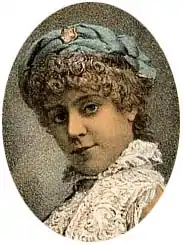
Born into a theatrical family, Farren began acting as a child. She made her professional adult debut in 1864 and joined the company at London's Olympic Theatre, performing in Shakespeare, contemporary comedies, dramas and musical burlesques. From 1868 to 1892, she performed at the Gaiety Theatre, which specialised in musical burlesque, becoming famous in the male and principal boy roles, which permitted an actress in the Victorian era theatre to show her legs in tights. Farren gained a large following among the theatre's mostly male audience.
Farren created the role of Mercury in Gilbert and Sullivan's first collaboration, Thespis and created or played roles in works by Dion Boucicault, Anthony Trollope, Charles Dickens, William Congreve and Henry James Byron, among many others. In the 1880s, she created roles in the series of famous Gaiety burlesques with musical scores by Meyer Lutz, often written by Fred Leslie. Some of her most famous of these later roles were the title characters in Little Jack Sheppard and Ruy Blas and the Blasé Roué. She also became a co-producer of the Gaiety Theatre.
After Farren suffered an attack of rheumatic fever in 1891, her health forced to retire from the stage in 1892. A gala benefit for her was arranged at the Theatre Royal, Drury Lane in 1898. It was attended by nearly the entire theatrical community at which the most famous actors of the day performed, and which raised the astonishing sum of £7,000 (equivalent to £786,000 in 2019) for her retirement.
Early life and career
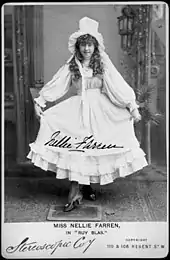
Farren was born in Lancashire to a theatrical family. Her grandfather, William Farren, was a well-known actor. Her father, Henry Farren, and her uncle, William, were both actors.[1] Her mother was Ellen nee Smithson.[2] Farren married actor and stage manager Robert Soutar in 1867,[2][3] and the couple had two sons, Henry Robert Soutar (1868–1928), an actor who ended his days as a general labourer,[4] and the actor Joseph Farren Soutar (1870–1962).[5][6]
Her first role was as the young Duke of York in Richard III in 1853 at the Theatre Royal, Exeter.[2] She first appeared on the London stage at the age of seven, at the Victoria Theatre, playing Genie of the Ring in Dick Whittington. Although she played other juvenile singing and acting roles in London and the British provinces,[2] she completed her education.[7] In 1862, she played the Fairy Star in The Rose of Blarney at Sadler's Wells Theatre, receiving good notices, followed by a series of other parts at the Victoria Theatre.[2] One of her last roles there is considered her adult debut, as Ninetta in The Woman in Red in 1864.[8]
Later in 1864, Farren moved to the Olympic Theatre, where she stayed for several years, playing in a number of pieces, including The Hidden Hand by Tom Taylor; My Wife's Bonnet by John Maddison Morton; the burlesques Prince Camaralzaman, or, the Fairies' Revenge and Faust and Marguerite; and Shakespeare's Twelfth Night, as the Clown.[8] She also played the title role in Lydia Languish, Charlotte in High Life Below Stairs, Nerissa in The Merchant of Venice, Nan in Good for Nothing by J. B. Buckstone, Jo in Nicholas Nickleby, and Sam Willoughby in The Ticket-of-Leave Man,[7] again earning praise for her comic portrayals.[2] The manager of the Olympic, Horace Wigan, and playwright Tom Taylor, each of whom directed shows at the theatre, taught Farren much about stagecraft and encouraged her to experiment and expand her acting.[9] During this time, she also played roles in other theatres, such as Pert in London Assurance in 1866.[2] In the second half of 1868, she joined the company at the Queen's Theatre, Long Acre, playing, among other things, Nancy Rouse in a F. C. Burnand's burlesque Fowl Play.[2]
Gaiety Theatre years
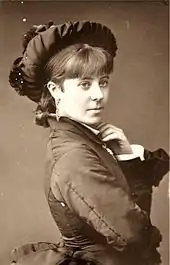
Farren began her long tenure at the Gaiety Theatre in December 1868, at the re-opening of the theatre under new management by John Hollingshead, playing Sprightly in On the Cards and the title role in its companion piece, Robert the Devil, by W. S. Gilbert, a burlesque of the opera Robert le Diable. This ran until May 1869.[10] Her husband, Robert Soutar, joined the theatre at the same time and served as an actor, stage manager and writer there.[11] Farren next played the title role in Alfred Thompson's Columbus!, or the Original Pitch in a Merry Key (1869).[12]
Farren continued at the Gaiety for the next 25 years, playing in comedies of all kinds and in Shakespearean dramas, first under Hollingshead and then under George Edwardes, performing the lead in dozens of shows, many also starring Edward Terry, Kate Vaughan, Fred Leslie and E. W. Royce. She was most acclaimed in the "principal boy" roles.[1][2] These roles permitted the actress to show her legs in tights, and Farren became very popular with the young men of the Gaiety audience, who would wear a coloured scarf to show support for their favourite actress. Farren's colours were dark blue, light blue and white, and she could look out over the audience to compare the number of fans displaying her colours as compared to the colours of the other actresses.[13] According to Hollingshead, Farren developed a "spinal complaint, which troubled her in her early Gaiety career [and] developed into locomotor ataxy" later.[14]
Some of her best known roles in the 1870s included Tilly Slowboy in Dot (Dion Boucicault's version of The Cricket on the Hearth); Miss Prue in Love for Love; Princess of Trebizonde (1870), based on the Jacques Offenbach operetta; Sam Weller in Bardell v. Pickwick; Mercury in Gilbert and Sullivan's first operatic collaboration, Thespis, or, the Gods Grown Old (1871); Ali Baba; Polly Neefit in Shilly-Shally (1872), by Anthony Trollope and Charles Reade; Leporello in Robert Reece's Don Giovanni; Antony and Cleopatra (1873); Clemency Newcome in The Battle of Life, (based on Charles Dickens's Christmas story of that title); the title role in Henry James Byron's Little Don Caesar de Bazan (1876, a send-up of Boucicault's play); Thaddeus in Byron's The Bohemian G-yurl and the Unapproachable Pole (1877); and title roles in Byron's farce Little Doctor Faust (1878)[8] his Handsome Hernani, or The Fatal Penny-Whistle (1879);[15] and Robbing Roy (1879).[1][2]
Farren's Gaiety pieces in the 1880s included Lutz and Robert Reece's burlesques of The Forty Thieves (1880), as Ganem; the title roles in Aladdin (1881) and Little Robin Hood (1882);[8] Ariel (1883, by F. C. Burnand, based on The Tempest);[16][17] Blue Beard (1882); Camaralzaman and Mazeppa (1884); perhaps her most famous role as Little Jack Sheppard (1885); Richard Henry's Monte Cristo Jr., as Edmond Dantes (1886); Dr. Frankenstein in Frankenstein, or The Vampire's Victim (1887); Miss Esmeralda, or The Maid and the Monkey (1887); Fra Diavolo, Gulliver, Rip Van Winkle, Sonnambula; the title role in Cinder Ellen up too Late (1891); and dozens of others.[18] Perhaps the most successful of her later roles was the title role in Ruy Blas and the Blasé Roué (1889, by Fred Leslie and H. F. Clarke, a take-off of Victor Hugo's play Ruy Blas),[8] which she and Fred Leslie toured in Australia (with Sidney Jones) and elsewhere in 1891. In 1888–89, she, Leslie, Letty Lind, Sylvia Grey, Marion Hood and the Gaiety company had toured the US and Australia with Monte Christo, Jr. and Miss Esmeralda.[19]
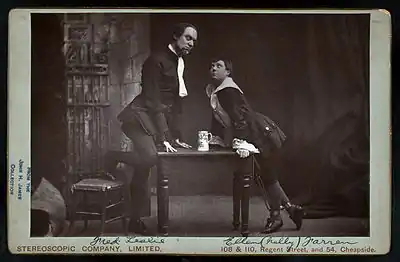
In addition to these burlesques, Farren also appeared in other comedies such as The Man of Quality (an adaptation of Vanbrugh's Relapse), as Miss Hoyden (1870); William Congreve's Love for Love, as Miss Prue (1871); Bickerstaff's The Hypocrite, as Charlotte (1873); The Rivals (1874) as Lillian Languish (1874) and as Lucy (1877); The Critic, as Tilburina (1874); Ursula in Much Ado About Nothing (1874); Maria in Twelfth Night (1876); The Grasshopper (1877, an adaptation of Henri Meilhac and Ludovic Halévy's La Cigale); and a number of farces.[2] James McNeill Whistler saw The Grasshopper and was charmed by Farren as the 'grasshopper', a girl who escapes from a circus troupe. In January 1878, Whistler made drawings of her in performance.[20] Another success was her Smike in Nicholas Nickleby (1886).[2] On 3 May 1886, the Gaiety Theatre was host to a benefit concert for its music director, composer Meyer Lutz, including a scene from his burlesque Little Jack Sheppard, in which Farren performed.[21] The same year, Farren helped George Edwards obtain the lease to the Gaiety and became co-producer of the Gaiety company's shows.[1] She toured in the US and Australia with Fred Leslie in 1888–89.[2]
Last years
Her last regular role at the Gaiety was Nan in Good for Nothing in a benefit for Lutz in April 1891.[2] Later in 1891, Farren suffered an attack of rheumatic fever while in Australia, performing in Cinder Ellen up too late, which aggravated her spinal disease. She had to withdraw from the London production of Cinder Ellen up too late. The spinal disease progressively crippled her, and by 1892, Farren had become too crippled to work steadily and was mostly retired from the stage.[22] In 1895, Farren had a partial recovery and managed her own company at the Opera Comique but had little success.[23] One piece by this company that was well reviewed was A Model Trilby; or, A Day or Two After Du Maurier, by Charles H. E. Brookfield and William Yardley, with music by Meyer Lutz. The piece was a burlesque of the Haymarket Theatre's hit adaptation of George Du Maurier's popular novel, Trilby.[24] However, Farren lost her savings on the venture.[2]
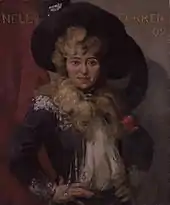
George Edwardes organised a gala benefit for Farren at the Theatre Royal, Drury Lane on 17 March 1898. The star-studded event, attended by a standing-room only crowd of 3,000 people (including her long-time fan, the Prince of Wales), lasted six hours.[25] It included a performance of Trial by Jury in which W. S. Gilbert played the Associate and Effie Bancroft played the "Associate's Wife", the barristers were all playwrights, the jury included many well-known comic actors, the bridesmaids included well-known leading ladies of the day mixed with real chorus girls from the Gaiety; a huge "crowd in court" made up of D'Oyly Carte Opera Company principals and other actors was also assembled. Principals included Barrington, Pounds, Lewis, Passmore, Lytton and Perry.[26] Also given was the premiere of a J. M. Barrie playlet, "A Platonic Friendship". Kate Vaughan danced, after an absence from the stage of twelve years. Henry Irving recited The Dream of Eugene Aram, Ellen Terry played Ophelia, Chevalier sang Mrs. Hawkins, Dan Leno gave Hamlet, Marie Tempest sang "The Jewel of Asia", and Hayden Coffin sang "Tommy Atkins."[25] In a pantomime, Ellaline Terriss played the Fairy Queen, Letty Lind played Columbine, Arthur Roberts was a policeman, and Edmund Payne played Clown.[27] Marie Lloyd and several music hall stars danced, Coffin appeared again, and Farren herself was discovered on stage with Charles Wyndham. Lydia Thompson, Kate Santley, Herbert Beerbohm Tree, John Hare, Clara Butt, and many other famous actors performed, as did the choruses of The Geisha, The Circus Girl and other popular shows.[25][28] Barely able to walk with the aid of crutches though only aged 49, Farren said a few words and made a joke. The benefit raised an estimated £7,000 (equivalent to £786,000 in 2019) for her retirement.[2]
Farren's retirement, coupled with Fred Leslie's death, brought to an end the type of Gaiety burlesque associated with them, at the same time that Edwardian musical comedy was taking over London theatre. Farren made a few appearances in her last years at benefits. Her last public appearance was at a "Nellie Farren Night" at the Gaiety Theatre on 8 April 1903. A performance of The Toreador was followed by The Linkman, a revue of old Gaiety hits in which she performed, written by, and featuring, George Grossmith Jr. At the end of the evening, Farren gave a speech from the stage.[2]

Death and legacy
Farren died in London in 1904, aged 56, of cardiac failure and was buried in Brompton Cemetery.[2][29]
Her gravesite was restored in 2014.[30] Her son Joseph was buried alongside her when he died in 1962.
In 1908, a racehorse was named after her.[31]
Gallery
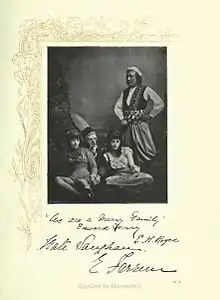 Photo and signatures of Farren, Terry, Vaughan and Royce at the Gaiety
Photo and signatures of Farren, Terry, Vaughan and Royce at the Gaiety Farren as Ruy Blas
Farren as Ruy Blas Sheet music from Monte Cristo, Jr.
Sheet music from Monte Cristo, Jr._Joseph_F_Soutar_gravestone_Brompton_Cemetery.jpg.webp) Farren's grave in Brompton Cemetery
Farren's grave in Brompton Cemetery
References
- Hollingshead, John. Gaiety Chronicles (1898) A. Constable & Co., London
- Parker, John (1912). . In Lee, Sidney (ed.). Dictionary of National Biography (2nd supplement). 2. London: Smith, Elder & Co. pp. 12–14.
- "Article about the Gaiety tour of Australia". Archived from the original on 23 September 2006. Retrieved 4 October 2007.
- "Death Certificate for Henry Robert Soutar (1928)", Ancestry.com, accessed 16 October 2013
- Farren Soutar, the Internet Movie Database, accessed 8 October 2013
- "Miss Nellie Farren", The Straits Times, 28 May 1904, p. 2, accessed 8 October 2013
- Reid, Erskine and Herbert Compton. The Dramatic Peerage (1892) Raithby, Lawrence & Co. Ltd., London, pp. 80–81
- Information from Footlight Notes website Archived 12 October 2009 at the Wayback Machine
- Hollingshead, p. 448
- Digital Guide to Gilbert & Sullivan Archived 31 October 2007 at the Wayback Machine
- Stewart, Maurice. "The spark that lit the bonfire", in Gilbert and Sullivan News (London) Spring 2003.
- "Information about the Columbus burlesque". Archived from the original on 11 March 2007. Retrieved 4 October 2007.
- "Hamilton, Frederick Spencer, The Days Before Yesterday (2005)". Archived from the original on 29 November 2007. Retrieved 4 October 2007.
- Hollingshead, John. Good Old Gaiety (1903) London, p. 14
- Information and images regarding Handsome Hernani, or The Fatal Penny-Whistle
- NY Times article that includes a brief review of Ariel
- Information about Ariel, 1883
- Plarr, Victor G. Men and Women of the Time (1898) G. Routledge, London
- NY Times article that describes the U.S. performances
- "Information about Farren, Whistler and Hollingshead". Archived from the original on 7 July 2004. Retrieved 4 October 2007.
- Information about several Farren performances
- Some information about Farren Archived 27 July 2011 at the Wayback Machine
- Culme, John. Footlight Notes Archived 5 September 2011 at the Wayback Machine, 14 June 2003, accessed 1 January 2010
- The Times, 18 November 1895, p. 3
- Account of the benefit by an audience member
- Cellier, François and Cunningham Bridgeman. "Gilbert and Sullivan and their operas", Little, Brown (1914), pp. 28–29
- "Letty Lind as Columbine, Drury Lane Theatre, 17 March 1898", Victoria and Albert Museum, accessed 28 August 2016
- "Notabilities to Take Part in the Nellie Farren Benefit – Sale of Seats Nets $25,000". The New York Times. 27 February 1898. Retrieved 6 August 2008.
- "First And Last Appearances", The Daily News, 29 April 1904, p. 7
- Nellie Farren and Farren Soutar grave restored, Latest News, The Music Hall Guild of Great Britain and America, 2 October 2014
- Nellie Farren, Standardbred racehorse
Bibliography
- Hilton, George W. Nellie Farren (1997) Sir Arthur Sullivan Society
- Hollingshead, John. Good Old Gaiety: An Historiette & Remembrance (1903) London: Gaity Theatre Co.